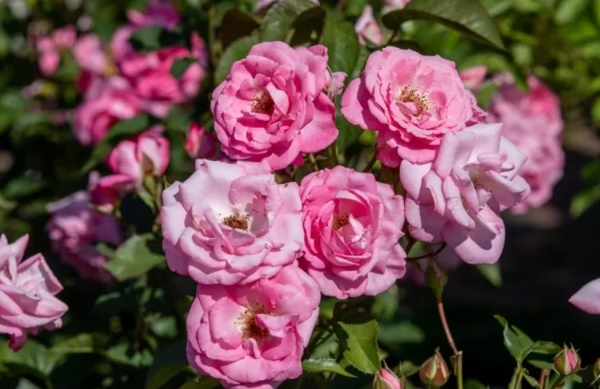
Shrub Rose
Botanical Name
:
Rosa spp.
Plant Type
:
Deciduous flowering shrub
Seasons
:
Plant in spring or fall; Blooms from late spring through fall (many are repeat bloomers)
Sun Level
:
Full sun to partial shade; at least 6 hours of direct sunlight per day
Ideal Soil Temperature for Planting
:
60–70°F (16–21°C)
Soil Type
:
Loamy, well-drained soil enriched with organic matter
Hardiness Zones
:
3–11 (USDA), depending on the variety
Germination
:
Seeds require stratification and can take several months to germinate; propagation is often done by cuttings
P.H. Level
:
Slightly acidic to neutral (5.5–7.0)
Water/Irrigation
:
Water new plants 2 to 3 times per week until established, then 1–2 inches of water per week; can tolerate short dry periods once mature
Fertilization
:
Use a balanced fertilizer with an NPK ratio of about 10-10-10 in early spring and again in midsummer; Apply 1 to 2 inches of compost or organic matter in spring to suppress weeds, retain moisture, and provide slow-release nutrients
Habit
:
Mounding, bushy, upright
Propagation
:
Seeds, cuttings, layering, and divisions
Final Plant Height
:
1–20 ft, depending on the variety
Spread
:
1–15 ft, depending on variety
Flowers
:
Red, pink, white, yellow, and orange; single or double blooms with varying fragrances
Attracts
:
Bees, butterflies, hoverflies, and hummingbirds
Uses
:
Hedges, borders, mass plantings, ground covers, and container gardening
Companions
:
Lavender, phlox, lamb’s ear, catmint, salvia, catmint (Nepeta), lady’s mantle (Alchemilla), perennial geraniums, and artemisia
Pruning
:
Prune in late winter or early spring; remove dead or weak stems to encourage healthy growth
Toxicity
:
Non-toxic to humans and pets; thorns can cause injury; rose hips are edible and rich in vitamin C
Pests
:
Aphids, Japanese beetles, spider mites, and rose slugs
Diseases
:
Black spot, powdery mildew, stem canker, and rose rosette disease
Fun Fact
:
According to the Guinness Book of World Records, roses are the oldest species of plant cultivated for decorative purposes. Ancient Romans, as early as AD 50, grew them in vast plantations and hothouses for medicinal, culinary, and ornamental uses—decorating buildings, furniture, and creating rose carpets and walkways
Botanical Name
:
Rosa spp.
Plant Type
:
Deciduous flowering shrub
Seasons
:
Plant in spring or fall; Blooms from late spring through fall (many are repeat bloomers)
Sun Level
:
Full sun to partial shade; at least 6 hours of direct sunlight per day
Ideal Soil Temperature for Planting
:
60–70°F (16–21°C)
Soil Type
:
Loamy, well-drained soil enriched with organic matter
Hardiness Zones
:
3–11 (USDA), depending on the variety
Germination
:
Seeds require stratification and can take several months to germinate; propagation is often done by cuttings
P.H. Level
:
Slightly acidic to neutral (5.5–7.0)
Water/Irrigation
:
Water new plants 2 to 3 times per week until established, then 1–2 inches of water per week; can tolerate short dry periods once mature
Fertilization
:
Use a balanced fertilizer with an NPK ratio of about 10-10-10 in early spring and again in midsummer; Apply 1 to 2 inches of compost or organic matter in spring to suppress weeds, retain moisture, and provide slow-release nutrients
Habit
:
Mounding, bushy, upright
Propagation
:
Seeds, cuttings, layering, and divisions
Final Plant Height
:
1–20 ft, depending on the variety
Spread
:
1–15 ft, depending on variety
Flowers
:
Red, pink, white, yellow, and orange; single or double blooms with varying fragrances
Attracts
:
Bees, butterflies, hoverflies, and hummingbirds
Uses
:
Hedges, borders, mass plantings, ground covers, and container gardening
Companions
:
Lavender, phlox, lamb’s ear, catmint, salvia, catmint (Nepeta), lady’s mantle (Alchemilla), perennial geraniums, and artemisia
Pruning
:
Prune in late winter or early spring; remove dead or weak stems to encourage healthy growth
Toxicity
:
Non-toxic to humans and pets; thorns can cause injury; rose hips are edible and rich in vitamin C
Pests
:
Aphids, Japanese beetles, spider mites, and rose slugs
Diseases
:
Black spot, powdery mildew, stem canker, and rose rosette disease
Fun Fact
:
According to the Guinness Book of World Records, roses are the oldest species of plant cultivated for decorative purposes. Ancient Romans, as early as AD 50, grew them in vast plantations and hothouses for medicinal, culinary, and ornamental uses—decorating buildings, furniture, and creating rose carpets and walkways
Written by Nondiah Khalayi – https://www.linkedin.com/in/nondiah-khalayi/

